In New Zealand Director Taika Waititi’s blockbuster film Thor: Ragnarok, a huge range of characters tell the story of Thor’s battle to save his people. In this piece we speak to ILM, Framestore, Luma, Method Studios and Double Negative about their work, with a special focus on rigging.
Facilities increasingly share assets, for example this film is the first time Framestore joined ILM to realise Hulk. Rigging, however, remains a uniquely facility based art. While most of the riggers we spoke to used some version of Maya, the role of the rigger is as much art as science. Rigging provides the scaffold for animators to inbune performance. This is particularly the case with rigging the faces of the characters.
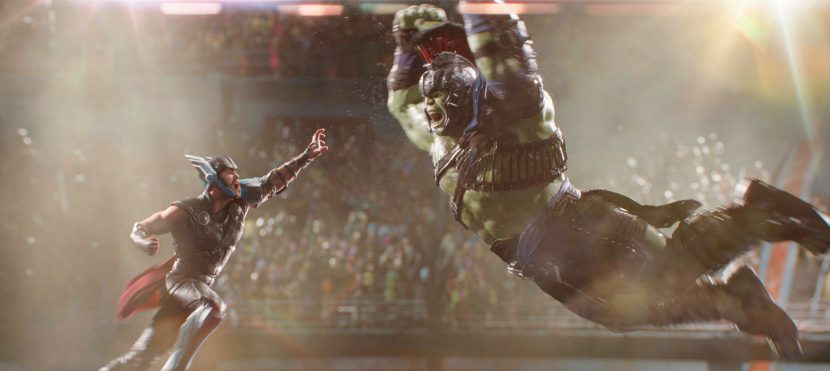
Rigging
Teams of dedicated specialists have been slowly improving rigging one shape at a time. Rigging has no silver bullet, no single tech innovation that has made rigging easier. It is the legendary Greek Sisyphus of visual effects. Sisyphus was punished for his self-aggrandizing craftiness by being forced to roll an immense boulder up a hill, only to watch it roll back down again for eternity. As audience applaud the performances of characters such as Hulk in the earlier Avengers films, the riggers face a new challenge each film. The bar is raised each time we see these performances and characters such as Hulk need to be taken further, which in the big green guy’s case means now sitting on the end of his bed chatting with Thor.
The complexity of rigging a Hulk to talk, or rigging a fire monster to grow to 4km in height while still being defined by fire is matched only by the need to produce seamless doubles for Cate Blanchett’s Hela, the Goddess of Death or Thor himself. Riggers roles are often passed over in discussion of character animation but their role is critical, as any animator will testify.
ILM
Hulk
ILM is the real visual effects home of Hulk, they have had a long history in developing and ‘solving Hulk’. The giant character proved extremely hard to translate onto film, partly due to the technical constraints of such a lead semi-human facial solve and partly due to his odd colouring and also from a performance stance. Hulk has once again evolved in this film. He has evolved from an aggressive and often confused persona that just grunted or smashed his way through scenes, to a more refined Hulk that has hot tubs and sits chatting.
Chad Wiebe, was the ILM visual effects supervisor. This is the first film he has supervised for ILM. He was previously at Method Studios where he played a key role in the Dr Strange visual effects, especially the so called “Magical Mystery Tour sequence”. Wiebe and the team at ILM worked hard to realise the new Hulk without loosing the Hulk that has been so successful in the Avengers films.
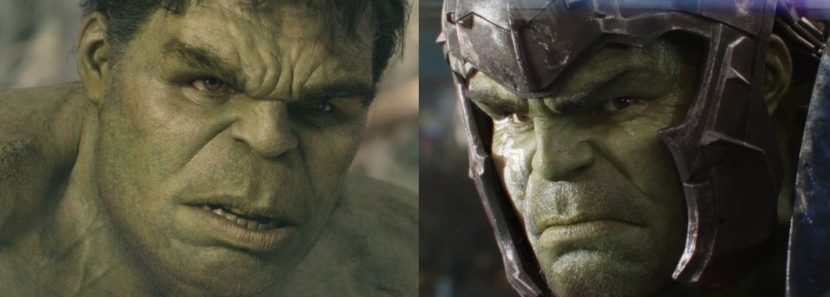
There was much discussion about how this Hulk should look, given that he would need to have much more dialogue than ever before. Previously his lines were limited to just a few words “Puny god” being the most famous. In the new film Hulk needed to have conversations with Thor, especially in the warrior’s apartment.
In the images above, note the size and sharpness of the new Hulk’s nose and the length of the philtrum (or middle area of the upper lip). The jaw is more chiseled and angular. The bottom lip and the nasal bridge are also significantly different. The eye sockets were brought forward, and less shaded by the eye brows, with a reduced brow ridge. The effect is to make Hulk seem more evolved and perceptive in thought. “Even subtle things like the shape of the eyelids and the groom of the eye brows were all updated” points out Wiebe. Many of these changes resulted in the new Hulk matching actor Mark Ruffalo more closely, but interestingly one thing that was not changed was Hulk’s ears “I think they were already a close match to Mark’s so they didn’t need to change much!” he adds.
While his body was similar, his face is greatly advanced. “it was pretty amazing how much of an update he got and how he has evolved into more of a human character, from this more unintelligent giant we have seen in previous films, .. we had a very specific directive to make Hulk more intelligent, heroic and really a super hero like all the other Marvel characters are” explains Wiebe.
ILM’s greatest challenge was rigging the new face, and having the ability for Hulk to cover a full range of phonemes. “We went back to scratch and got Mark (Ruffalo) in the chair doing a new Medusa capture. We went for a full range of motion (ROM), we captured about 90 different expressions in the Medusa, and from there we built an entirely new library that would allow him to cover a full range of normal human visual characteristics”, explained Wiebe.
The Medusa data went to the modeling department, the team then selected all the key pose data of Ruffalo, they wanted to map and ingest into the ILM Library for model versions of Hulk. Importantly all these models share the same topology and provide cohesive mapping between expressions. This both provides Hulk expression meshes(blendshapes) with any additional detail etc, and it cleans up the Ruffalo data meshes. “Our Banner model and topology is the same as our Hulk topology, so everything we do to Banner or Mark Ruffalo applies to our Hulk asset”, he adds. In the ILM pipeline, the team actually animate a digital Ruffalo/Banner before retargeting this to Hulk. The two are modelled off the same generic mesh so all the Medusa data and its (Ruffalo) shapes can be solved into FACS space and that can be used on a later Mark Ruffalo performance capture to drive the animated Hulk asset. As the faces are dramatically different the retargeting involves skilled artist input.
As with recent past ILM character film work, the overall ILM face pipeline is supervised and developed by ILM’s Brian Cantwell. During earlier stages of production/post, the ILM team, under Cantwell, used Ruffalo’s performance to more directly drive a Hulk asset, just to see what this initial pass would look like. Given ILM’s highly advanced face pipeline from films such as Warcraft, this ‘direct’ version, while unable to be easily edited or adjusted, does give a remarkably good quick result. “You don’t have any control over it, it is literally a mapping of the data onto the Hulk mesh,” comments Wiebe. “Those early tests do give you a fairly high level of detail, but you don’t have much control. You can’t do performance override, for example, what you get out of that stage is Mark’s direct performance, but what you always want at some point is to be able to push it further or tweak it, or even completely redo it, if the script changes”.
In the past Hulk was a rage filled character, who primarily fought on scene. In this new film ILM needed to explore a ‘quiet’ Hulk, one that was ‘relaxing’. This was the case with the Warrior apartment scene. While all the relevant data was collected, at the point of filming this scene, the production did not really know how Hulk was going to talk, or with which exact approach he would be realised. “A lot of that was determined after we left principal photography”, Wiebe explains. Ruffalo wore a head cam for his dialogue performances and the team explored a range of approaches back at ILM as to how Hulk would appear in those scenes ranging from child like to pure serious rage. “We were just working out what a talking Hulk should be” Wiebe concludes.
On set to help with the interaction with actor Chris Hemsworth there were a number of life sized busts of Hulk and a large puppet upper body Hulk that could be used as a stand in. “for one particular shot where Thor needs to jump on Hulk’s back and put him in a choke hold they used an articulated upper body Hulk rig that they used to give Chris something to work with,.. there was a wide range of things to help on set”, comments Wiebe. This also included the stunt doubles for both Thor and Hulk being cast as two very different height stuntmen. Paul Lowe, (The Dark Knight Rises ) who is under 5 feet tall doubled for Thor so that the Stunt men for Hulk would proportionally be the right height. As there was clearly no way to hire a 8 or 9 foot tall stuntman for Hulk. 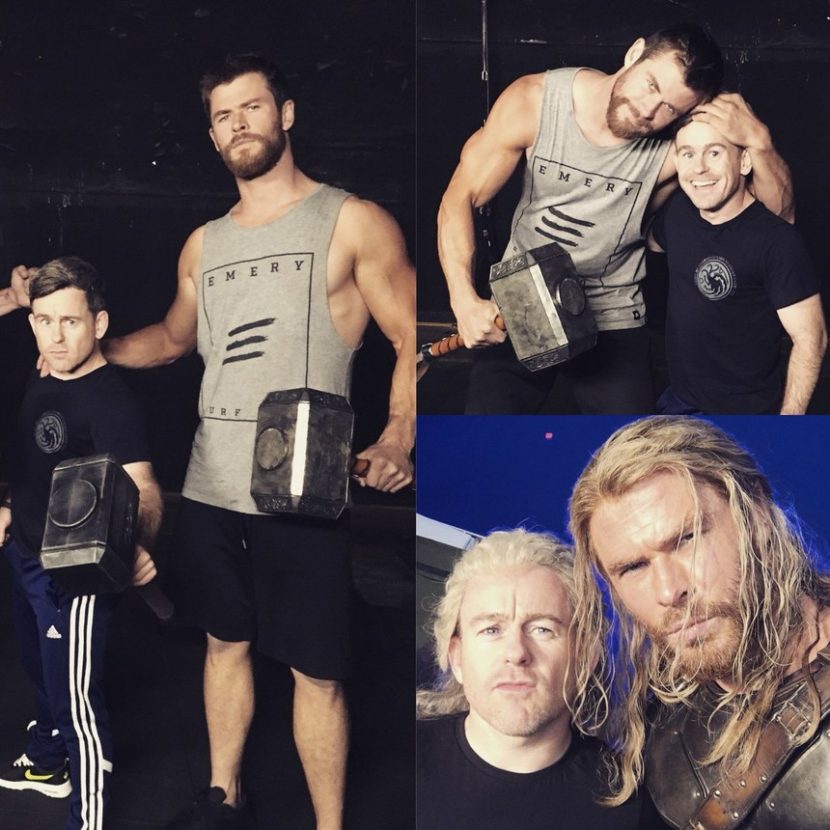
This approach also naturally required a digital Hulk as well, and one that could be intercut with Chris Hemsworth seamlessly. ILM developed a detailed body double for Thor himself. “There were a lot of shots where we just had to do a fully digital Thor and that gave us a lot of flexibility, and a lot of room to make sure the shot was exactly what the director wanted… we didn’t have to pull any punches!” Wiebe jokes.
The Quinjet transformation was actually inspired by a sequence from the film Altered States, the director specifically was interested in referencing William Hurt’s transformation performance in that film. The logic is that Hulk does not want to give up his control and allow Banner to come to the floor and to transition. The idea was a fight with one’s own self, made tangible by the body being hit and throwing one’s self against the walls. Banner effectively hits (himself) into the walls of the quinjet to ‘smack’ out the Hulk, or perhaps if is Hulk trying to smash himself to invoke rage to maintain his Hulk persona. Either way the calming words of Black Widow do overcome the Hulk and ILM transitions the Hulk back to Banner. The scene was logically different from the Avengers transformation as Banner was meant to have been Hulk for the past two years, and as his dialogue indicated the Hulk was more in control than past short transformations.
ILM did the majority of Hulk work, but for the first time not all of Hulk. ILM did the dramatic arena fight, the warrior apartment and the quinjet but not the Hulk seen in the end fight sequence. For that, ILM handed over their Hulk assets to Framestore. Hulk was rendered as deep data by ILM in RenderMan. Framestore used their heavily customised version of Arnold, but the character rig needed to be completely redone. In the range of transferable assets, rigging is almost completely per facility proprietary.
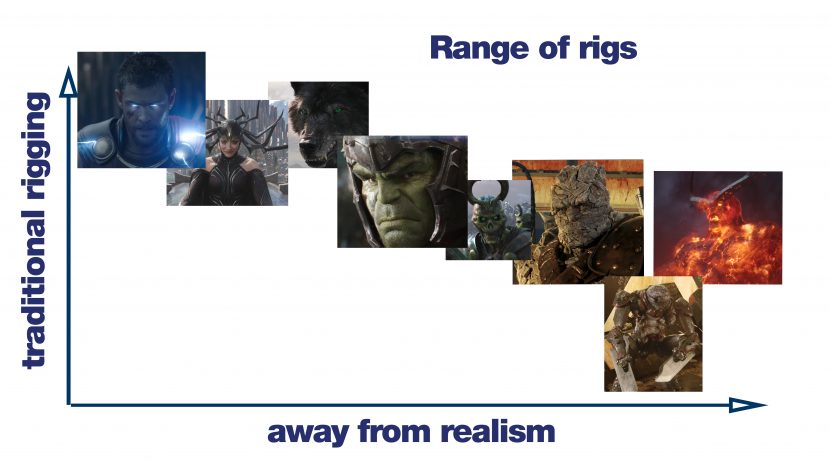
Framestore
This film represented a great mix of rigging problems for Framestore. In a sense the characters varied in both facial realism and range of style of characters.
If one was to graph Framestore’s character work, one axis there would be a continuum of characters from the realism of a close up DigiDouble of Hela, through a digital Hulk, to less humanoid characters such as Korg, and then the fiery Mega Surtur. Each of these is progressively less human in form but each were fully rigged. On the other axis there would be the range of characters from a normal bi-ped human character such as Thor’s digital double, up to quadrupeds such as the wolf like Fenris and finally the Sakaaran warrior Meik.
This was a very big show for Framestore especially on hero characters. At the peak of production there were 13 riggers working on the film at Framestore. Overall the team delivered 459 heavy duty VFX shots.
Framestore primarily worked on the third scene battle. The complex showdown was prevised by The Third Floor, and live action plate photography was shot on a set representing Asgard’s Stone Arch Bridge. During post, script changes relocated the action to the more familiar Rainbow Bridge, a colourful, reflective surface on which Framestore’s character fought. Behind the characters, the Framestore team built an entirely CG Asgard environment containing over 9,000 buildings based on upgrading assets from DNeg left from Thor: The Dark World.
The rigging team published 263 rigs, 63 were character rigs, and over 60 vehicles and 50 key props and importantly three different crowds. “This amount of rigs is a lot and we relied on some unique workflows to accomplish this, including having crowds use our automatic rigging setup” comments Lars Johansson who was the Lead Rigger at Framestore in London on Thor.
The three crowds Framestore used were a crowd of female and another crowd of male refugees fleeing Thor’s home world from the third crowd which was hundreds of attacking resurrected enemy D-Guards.
Hulk
Framestore was the first company outside ILM in the modern Marvel Cinematic Universe to work with Hulk. ‘The whole team was incredibly motivated to get to the best possible Hulk’, says Alexis Wajsbrot, VFX Supervisor. The team used its proprietary ‘Flex and Flesh’ muscle and skin sliding tools for the task. ‘The behaviour of the muscles was physically based’, adds Harry Bardak, CG Supervisor. ‘We had a collision system between muscles, then the skin colliding with the muscles which created small wrinkles.’ Built into Framestore’s Hulk rig was a new multi-subsurface system that scattered light through skin, muscle and bones. This was previewed at SIGGRAPH in LA in August by Nathan Walster as part of his presentation on Framestore’s work on Guardians of the Galaxy 2. This path-tracing Monte-Carlo sub-surface scattering (SSS) offers a simple and yet impressive approach to solving volumetric integration problems previously considered too computationally expensive for production use, particularly for highly scattering media, such as semi-translucent SSS skin.
Animators brought Hulk to life through keyframe animation. For Hulk’s facial performance, the artists used the blend shapes supplied from past films, enhanced by dynamic flesh simulations. A collaboration with Marvel’s ‘Hulk specialist’, concept artist Ryan Meinerding, helped to inform the subtleties of his facial expressions. ‘We actually redesigned our shot-sculpt pipeline in order to have maximum control and to be able to be very reactive to this feedback’, adds Wajsbrot.
Korg
Taika Waititi’s comedic Korg required the team to devise a CG rock-monster, capable of witty dialogue and performance. Unlike Hulk where Framestore received assets, with Korg, Framestore developed the character and then passed his assets on to Luma Pictures for some of the earlier scenes where he is introduced.
Korg is made up of thousands of individual rocks, a complex collision and deformation rig that supported a constantly-moving rock mosaic was constructed. ‘We could push the asset to deliver different types of performance, and still get a realistic feel in how the rocks fit together’, says Kyle McCulloch, VFX Supervisor.
“Korg was very unique in his face, luckily we started looking at him very early on” comments Johansson. The rig is actually based on a basic human digi-double with a traditional bone skeleton, muscles and even a skin layer, but on top of this was another layer that provided the rock appearance and managed the intersections. The riggers split into two teams initially one to handle his body and one to focus on his face. In the end a common solution was found to both, but with much smaller sized rocks being used on his face.
The earlier version of the face had more space between the rocks, some of which can still be seen in his biceps for example but it was decided to have a tighter rock construction on the face. “We went through a lot of iterations with Korg and a lot of different ways his face could be displayed”, adds Johansson. A lot of complexity is introduced in the face by having all of the face including the eye balls made of the same rock material. Much of this had to be addressed by subtle and crafted lighting so that the audience could still read his expressions, explains Matthieu Goutte, Head of Rigging. “This was before the technical issues of animating him. Once we had the design, – perhaps 4 or 5 iterations to get the look the director was happy with, we ran the simulations on Korg moving, so that the main muscles would move correctly”.
The performance and motion capture of Korg was done by the director Taika Waititi himself. But to help Waititi, Framestore developed a new workflow, especially for Korg’s face. The Director, when working as Korg, wore a Technoprops stereo head mounted camera rig (HMC) with markers on his face. The team took the data from the solve of the camera and used that to feed their Point Based Deformation system (PBD). This system allowed the team to take a small sample of a particular set of the facial data and retarget into any particular geometry of the face. “So effectively we were able to take the data stream from the HMC of the director and retarget this against a crude version of Korg early on, which gave us a very nice indication of the character in context of the shot” comments Goutte. In other words, there was no solve into FACS space, it was a “quick and crude interpretation for the director’ he adds.
This direct version was primarily designed as a tool for post-viz, since the final animation was heavily hand crafted to produce refined comic timing and general animation for the final version. Korg’s face was rigged with a standard Framestore rig, but it was done without any ‘flesh’ or rock simulations. The cool thing about Korg is that all his face was deformer driven”, comments Johansson, “it was all deformer and node based, which we are quite proud of”. The team tried tests with a simulation layer on the rocks, but in the end the team “opted for what was coming out of the rig. We gave the animators the full set up, – it was fast enough for it to be in an animation rig so that what the animators saw was what they got when they were animating his face”. The entire rock ‘skin’ over all over Korg’s body was driven by this node approach and not simulated.
‘After the rig did its work, a team of artists went in and really polished how the rocks moved.’ Nowhere was the rig’s articulation more critical than in the face. Smaller stones were arranged around Korg’s eyes and mouth, allowing the character to speak and express subtle emotion.
One aspect that was complex has providing a leather armour over the top of the rock skin that would both move correctly and also not collide with the smaller rock edges that it sat over. “On top of all those rocks we had to somehow solve the costume. We tried to do as much as we could in the rig, but then we passed certain parts of it over to the effects team who simulated part of the costume, he was a challenge but he was fun,.. it just became fun” explains Johansson.
Mega Surtur
Towards the end of the sequence a super-sized Surtur, the ‘Titan of Fire’, appears to add even more chaos to the epic finale. Heavily augmented with fire and lava effects simulations, Surtur’s prodigious growth spurt elevates him to a height thousands of feet over Asgard. ‘From the start, Taika felt quite strongly that even though Surtur was planet-sized, he shouldn’t appear to move slowly’, explains McCulloch.
The animation team worked on different variations of performances, working to find exactly the right balance of threat, speed, and scale. They looked at sword fighters, wrestlers, and bodybuilders for inspiration on the shapes and poses to use on Surtur, always keeping in mind his new-found strength and power.
‘The brief for Surtur included references to the surface of the sun, plasma, lava, and fire’, adds McCulloch. ‘The LookDev team spent months partnering with our shader writers, experimenting with a myriad of ways to have something feel huge, somewhat transparent and refractive, while still seeing a visual complexity and surface.’
Surprisingly, the rig for Surtur was remarkably human and actually required a full skeleton, muscle and skin layer. If one looks closely, the character is actually semi-transparent, so unlike other characters one can see into the actual ribbon muscles on his chest, or the way the biceps come from the scapula. “He was rigged like any other character, he had a full anatomy” explains Johansson. “He was deformed with full on muscles. Being semi-translucent, we were not just rendering the final skin, we were rendering all the anatomy for the effects guys and lighting. We had to spend additional time detailing the internal anatomy, the bones, the teeth, the muscles, – making sure it was all as flawless as possible”. The transparency was artistically controlled by the artists as part of the overall look of the character.
The FX team then built a fire simulation system that could wrap and define Surtur’s body, perform within the space around him, and have the visual scale of detail required to sell how big they were.
Sunny Teich was leading Mega Surtur FX. Each Mega Surtur shot involved running 45 fire patch simulations in parallel, depending on the resolution, “this allowed us to take sims that might have taken multiple days to run, and instead turn around an iteration overnight” she explained. “We ended up going with a look where there was more fire distributed around his silhouette, so the facing ratio of the mesh normals to the camera, factored into how much emission there was on any given patch” she explained
During the sequence Mega Surtur grew. He ranged from roughly 800m when he first appeared to about 4,000m when he finally destroyed Asgard. In order to compensate for this change in size and keep a consistent fire look, the character was scaled down to a specific size before running the simulation. Then the fire was scaled back up accordingly to whatever size he happened to be in that particular shot. For example when he was the initial 800m tall, the average voxel size was 16 cm . When he was the final 4,000m tall, the average voxel size was 80 cm.
“At a given frame, the average number of voxels in a hi-res sim was on average roughly 2 million per patch (90 million in total)” Teich explains. “We were having trouble selling the scale of the fire until we started running it at different frame rates – 48 fps felt visually better”.
Fenris
At 23 feet tall, Fenris, Hela’s giant wolf side-kick, dwarfs even Hulk. The animation team used low camera angles and tight framing to communicate the wolf’s immense size. Groomers covered Fenris with around 12million hairs, which become wet when the two characters crash into the water at the edge of Asgard, in a battle of the giants. ‘Some of our best animators focused on the posing of both Hulk and Fenris to get the strongest positioning, and we put forward a lot of different options to Taika’, says Wajsbrot. ‘We even proposed some new shots – one close-up of Hulk fighting Fenris in the water made the cut!’
For the rigging team, Fenris is most like an existing real world beast. The proportions and thus the rigging was well understood. “The way rigging works is based on templating so we can transfer rigs between assets,.. and Fenris was derived from other experiences with things we had done before, wolves and dogs. Fenris was setup designwise exactly like a wolf’, explains Johansson. What made Fenris complex was having such a large creature in the water with Hulk.
Having close-up shots of the rapid water, and giant CG creatures splashing around in it, made it difficult to maintain clarity for audiences to follow the action but still feel like natural water simulation. ‘The first simulations were obscuring our heroes, so it was all about finding the right balance between making the water sim big but still showing the performances’, adds Wajsbrot. ‘We did push the limit of both our internal water solver flush and our rendering engine Arnold to get the best water sim.
Luma Pictures
Korg: Paper Rock Scissors, Bro.
Luma Pictures worked on 8 sequences in the film, in both Los Angeles and Melbourne, and in particular on both Korg and Miek. In total, the team did over 200 shots for Thor :Ragnarok.
Luma handled the visual effects for Korg meeting Thor in the prison and at the Stadium, both in the arena staging area and watching the fight.
Luma got both motion capture data and the voice over from the shoot, and the primary Korg asset from Framestore. The team started the animation process by making a walk cycle development, “We were focused on his weight, we wanted to explore how heavy this guy was, because although Taika Waititi did an amazing job with the acting part, there is still a physical part of the character that we needed to look at, in regards to his mass.” explained Luma Animation Supervisor, Raphael Pimentel.
Framestore had rigged the their own Korg, but as with other such characters throughout the broader production Luma needed to re rig Korg for their animation pipeline. “We can’t use other vendors rigs, as it doesn’t work with our pipeline, and we wouldn’t want to either as we have our own proprietary tools” Pimentel explains. All of the complex custom character tools Luma has, are deeply embedded in Luma’s pipeline and are attached to the rig. The animators GUI and animation tools that they have known and honed their skills with, are proprietary rig related elements. Luma clearly wants to support their animators by not changing this environment and allowing them to focus on the creative animation. Luma did take the model and convert some of the shaders to fit in, but unlike the rig, the model is highly transferable. As Framestore had already worked on Korg for several months the model was close to final. “Once we started rigging the face, we spent time modifying our rig to make sure we could get the acting of Taika (Waititi) into the rig,… a little bit of tweaking was needed to get the shapes we needed and to produce the correct phonemes, for example, without producing any gaps or errors on the face”.
https://www.youtube.com/watch?time_continue=4&v=OIAp8atjuTs
The rig was driven in different ways, sometimes Luma favoured the motion capture data, sometimes the team used more of a matching ‘rotomation’ approach. For the fan favourite scene when Korg first meets Thor in the prison (and a small rock part of Korg breaks off and falls to the ground), Pimentel and the team started with the Taika Waititi performance, slowed down the limb movement “because he looks down when Thor says – What about you, you’re made of rocks, and Korg says well sure but perishable rocks’,.. the weight and timing as he looks down needed to adjust to account for his mass and make Korg feel as dense and solid as he is”. But the timing of the dialogue and all the mannerisms is from the director’s performance on set, but as the team discovered if they did not adjust some of the timing Korg looked like he weighed only 65 kg even with the spacial volume of the Korg asset.
One of the remarkable aspects of Luma’s work is that they made the scene stealing CG Korg so effective in his acting. They could not do sticky lips, eye lights, or eye wetness, all things that senior animators creatively use to bring a character to life, and yet Korg’s facial performance is completely enchanting.
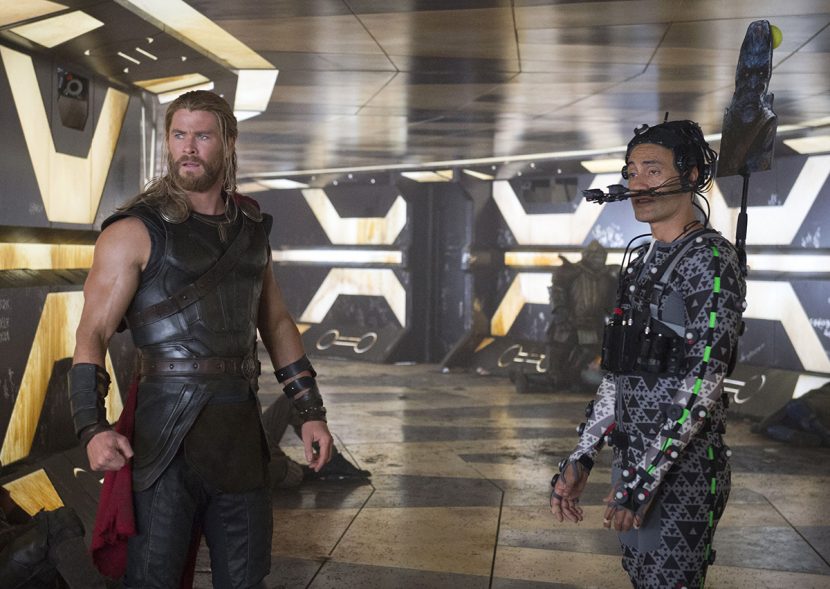
On set, Taika Waititi wore a motion capture suit, a head capture camera (HMC) which was set up for left and right side facial capture, and sometimes a fake head rig to provide a higher eyeline for Chris Hemsworth to look at. The side by side cameras vs. the increasingly popular above and below camera rig on the HMC was handy as Luma discovered that Taikia frequently delivered lines speaking more out of one side of his mouth when acting as Korg. The Head cams footage was not used directly, but as invaluable reference. The first stage in the animation process is to use the rig to match exactly Waititi’s performance with Korg. “What I like to do is put one camera looking at his face on one side of the screen, and the other head camera footage on the other side of the monitor and our animation in the middle, so then i can review these shots with Taika’s performance .. and we see how everything is lining up” explains Pimentel. The team then integrates the motion capture of the body and they start working out how to tweak and adjust the animation to give Korg weight, especially when he walks or moves. At this point Pimentel is looking for ‘delivery cues’, key parts of the acting performance that they do not want to change. They then set up building and adjusting around those key cue points perhaps slowing down some other less critical part of the performance capture so Korg appears on screen as Korg and not as if it was a guy in a light weight bulky suit.
Over the years Luma has built it’s facial rig, the earlier rig they made for MCU’s Thanos was the first FACS rig that Luma built and they have been improving ever since. “We now use that base rig for new characters. The base technology we use today, is built on that core technology started 5 years ago”, outlines Pimentel.
In finalising Korg, Luma spent a lot of time to make sure that Korg’s eye were reading given his stone material and that they were perceived to be looking at the right place, in the right direction. “The brilliance was there right off the bat in the dailies, with Taika. And then when we started Animating Korg and bringing him to life I remeber thinking Holy Sh*t – this is going to be so awesome. We knew from the beginning …this character was going to be special” remarks Pimentel.
Miek
Every character requires its own solution, and this was particularly the case with Miek. The character is a Sakaaran Native member of the Warbound, and is actually a significant player in some Hulk stories, so this first introduction where Miek is a silent sidekick may just be a prelude to a bigger future role.
Miek is a warrior thanks to his bladed suit rig. Early on in the process Jake Morrison, the visual effects supervisor was insistent that Miek be as likable as Korg, even without having any dialogue. Morrison instructed the team to have Miek always active, very agile, always moving. The character model was done by Framestore and “he is essentially a worm with an exoskeleton” remarks Pimentel.
For this character there was no reference motion capture, so Luma mounted their own MoCap session. For the action martial arts sequences, the company hired stunt performers. For the more direct acting and reacting performances needed for Miek, Pimentel decided to do the MoCap himself. “The cool thing is that sometimes it can be distracting to have another character moving next to a main character who is delivering dialogue, but with Miek we could not go far enough,… no matter what we did, it seemed to work and Jake and Taika said do more!”
If you look carefully at the rigging for Miek, the character is now directly wielding knives, he controls the blades from small joystick type controls close to his body. Additionally he stands on what are effectively Miek stilts that support him off the ground.
Miek, as with Korg, was lit using Katarna and rendered in Arnold. In the final render of Korg there are 1334 rocks making up his body (give or take one that drops off!).
Method Studios
Method Studios also delivered a large number of shots for the film, over 450 shots, including the opening scene in which Thor battles Surtur and his fire demons in a rocky underground hellscape of Muspelheim. They also handled the mid film major fight sequence that sees Hela take on an army of hundreds of Asgardian Guards. A key character was Surtur. The character posed new and interesting problems as he sits and quietly talks to Thor, the whole time being made of lava and fire. It is far more common for such a character to be in an action or horror sequence, rather than comic dialogue.
Method VFX Supervisor Andrew Hellen worked closely with Director and VFX Supervisor Jake Morrison throughout production, helping refine the looks and movements of CG characters and large-scale environments.
“Marvel’s concept art provided a solid jumping off point for all our work, and staying true to that creative, we translated that 2D artwork to the 3D final” comments Hellen. “Fleshing out Surtur, the dragon, the fire demons and the E-Guard soldiers for later shots was all a very iterative process that was driven by the creative”.
Method actually developed a version of the later ‘Mega Surtur’ during the pre-production phases, but as schedules shifted that work was moved to Framestore. Method shared this large scale asset with them to allow Framestore some reference to build their own Mega Surtur.
Surtur in the opening sequence is just 18 feet tall, which is still much larger than Thor. Surtur is established as an imposing presence with writhing and crusted magma flesh, created entirely with keyframe animation.
From an animation point of view the Method animators were given an imposing set of limitations by the nature of the script. The character needed to talk and sit with Thor, but if one looks at the facial limitations the character design dicated:
- no direct directional eye movement,
- no upper forehead or eyebrows visible (due to the helmet),
- no eye wetness or pupil spec highlights (no eye lights in other words),
- no sticky lips &
- no flushing, blushing or normal facial skin cues etc.
Method looked to it’s riggers also with the simulation and character effects teams to provide the tools to allow the animators to deliver a great performance. For example, to address the way someone’s face reddens as they upset, the team slowly increasinged the fire on Surtur’s face steadily during the overall scene.
Method artists achieved Surtur’s unique look using geometry as a Maya base model rig which then had textures of flowing magma added. These were defined in Houdini based on a muscle system to give directionality to the magma. On top of this the surface of the ‘skin lava’ cracked and this allowed wrinkle like facial features. For more defined aspects of the face the team hardened the lava to hard slag and this decreased transparency and increased contrast/expression readability. This sculpted slag added definition, and allowed for some rigidity for facial features. To complete the volcanic effect, artists added FX-driven fire, embers and smoke. Method used Houdini as their simulation tool, but the outputs into Nuke were both from Houdini’s Mantra and from the primary V-Ray renderer.
The facial expressions were driven by the rig muscles system, but there was effectively a secondary muscle rig which was included just to be seen through the transparent skin. Given the character is partially transparent these muscles were rigged independently of the normal character ‘muscles’ that drive shape deformers. While most of the time the rig logical muscles move in sync with the character’s visual muscles, they were separate.
Facial rigging posed many challenges, unlike in later sequences in the third act, there is detailed lip synced dialogue that the character model was required to achieve. Clancy Brown provided the voice over for the character. Method received footage of Clancy delivering his dialogue, but the character Surtur was hand animated for both his face and body.
Originally, Surtur was going to be much more gaseous and the audience would see his skeleton more clearly. In the end this was modified and the gas elements turned into fire, magma and importantly slag. The cooling slag is naturally darker. This meant that in addition to being able to produce more solid forms, the team could use the slag for the full frontal nudity shots. The naked Surtur had his modesty managed by darkening down sensitive regions with slag and having them not particularly visible or defined to the audience.
The smaller fire demons, which are closer to Thor’s stature, feature much more slag than Surtur and shatter when impacted. For wide shots of the fire demon force, artists animated the close-up action and then used crowd software for the thousands of fire demons that swarm Thor, descending from the roof and down columns of the cavern.
Motion capture footage of stunt performers provided reference for the fire demons’ movements, which artists expanded for the final characters to appear more animalistic. For example their knees are reversed, and their ankles pulled back so they effectively run only on the balls of their feet.
While much of the sequence is full CG, Thor is largely practical, though Method artists created a digital double used in a number of shots. ILM provided the base Thor that Method then re-rigged and used for fight sequences.
Live action plates were captured on a small partial set, then artists created the vast cavern environment of Muspelheim digitally, complete with a flowing lava wall. The look of the exterior Muspelheim was influenced by the rocky and inhospitable Dirk Hartog Island off the western coast of Australia, for which Hellen covered the on-set VFX supervision of an elements shoot.
In addition to Surtur and a legion of fire demons, Thor also encounters an enormous dragon, a wingless CG creation that flies by shooting fire from its gills. Artists referenced footage of rocket launches and used the straight, fast flame from the engine to guide the development of the dragon’s propulsion flames. From there, they adjusted the amount of thrust so the result was believable but not too forceful. The creature’s skin was modeled after Surtur, but with a more leathery aesthetic.
Method’s work can also be seen in a sequence where Hela arrives at Asgard and fights with hundreds of D-Guards, decimating them all single-handedly. The high action sequence features a CG Asgard environment, hundreds of CG “E-Guards,” FX destruction and a CG Hela. Hela and the D-guards posed another key rigging project for the team, but based much more on traditional anatomy.
The choreography of this fight sequence required collaboration between animation, technical animation and FX as Hela fires out hundreds of weapons impacting the environment, CG characters and plate characters. Timing was key when bringing all of these elements together. As with all of Method’s Hela shots, Hela was crafted using Cate Blanchett’s face from the live action plates, with motion capture data supplied for creating an all CG Hela body, costume and headdress.
Double Negative
Stuart Lashley was DNeg’s VFX Supervisor for their sequences of the film which mainly centred around Thor’s arrival on the planet Sakaar, before he heads into the gladiatorial duel against Hulk.
Much of the set was built on location, but DNeg built out the environment and extended the junk yard landscape. At this first location DNeg worked on just over 120 shots. “The art department had a good amount of junk and debris, it was a good sized set, but we were trying to show such a vast area that we still had to add a lot of additional fully CG environment, to extend it” comments Lashley.
As part of this the team also needed to deal with the portals in which derbies falls through. The biggest of these was key to the team’s escape. Our heroes reluctantly team up and form a plan, with Loki’s help, to steal a ship and fly through the largest portal, The Magnatar Wormhole or ‘The Devil’s Anus’. Valkyrie provides weapons to Korg and the other trapped champions so Korg can lead his long awaited revolution as a distraction. Digital Domain also worked on sequences that involved the same wormhole and the two teams blended their creative outputs.
DNeg also did a smaller scene in Val’s apartment and again DNeg replaced the blue screen exterior with the Sakaar environment. This sequence totalled another 70 shots.
One of the interesting props was the net that Val uses to capture and contain Thor. There was no net in the plate photography that DNeg used for those shots. Chris Hemsworth was filmed with and without a practical net, but in the end it was easier to not use the practical rope net. “No matter how much we added to it,..you could always tell it was a rope net, so we decided to use a version of Chris without any net and add a full CG net” explained Lashley. The design of the CG Net was visually linked to the neck restraint that then kept Thor from escaping.
Not all the character stunts were done with body doubles. Val’s drunken fall was done in camera, and a particular favourite of the Director. “This was always a shot Taika was very particular about … the comic timing was very important to him, and that particular fall worked exactly for the timing he wanted!” adds Lashley.

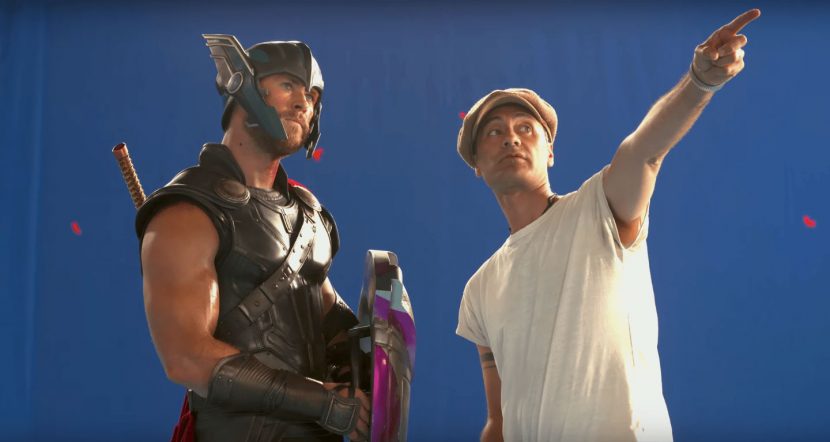
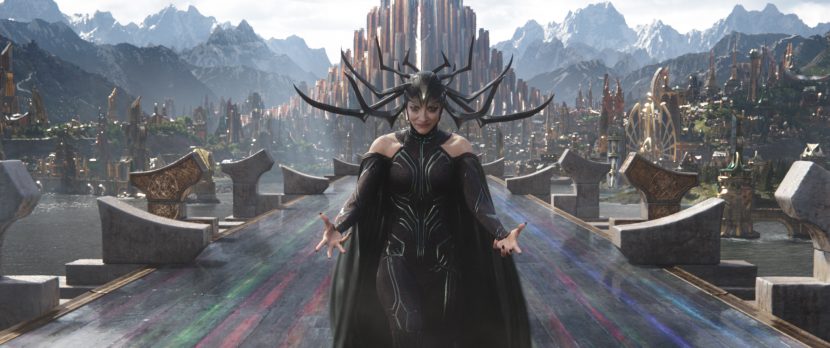
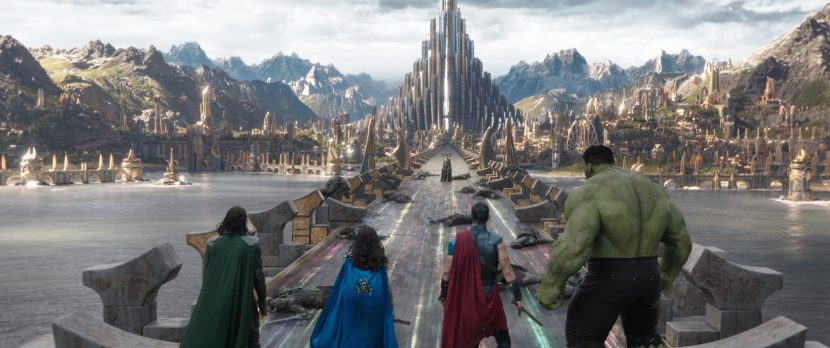
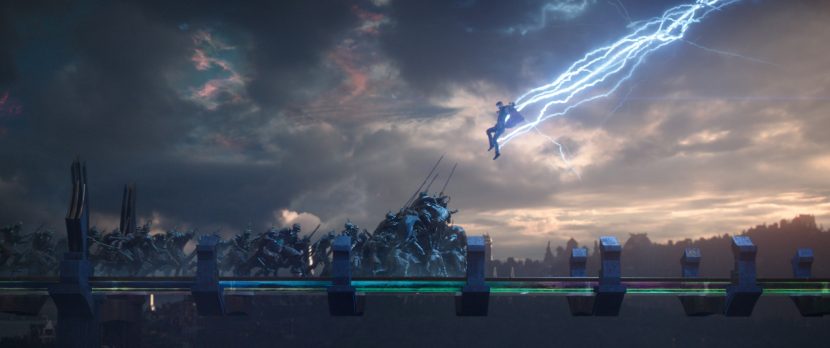
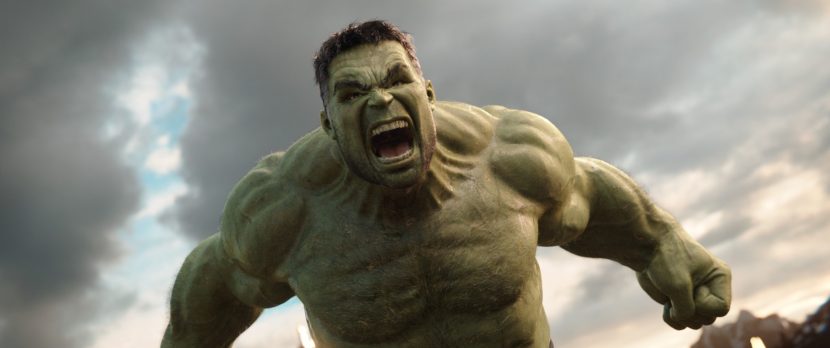
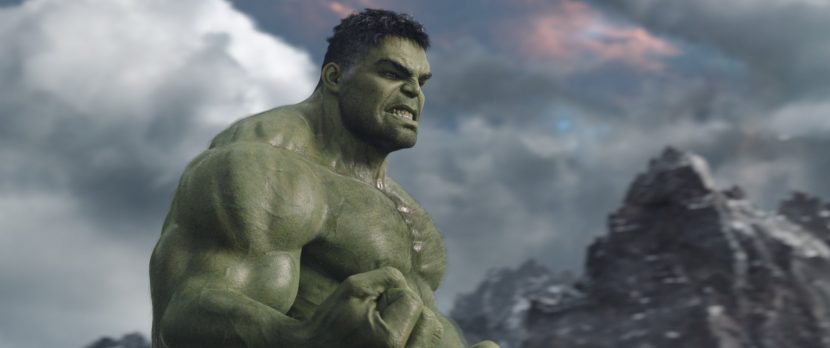
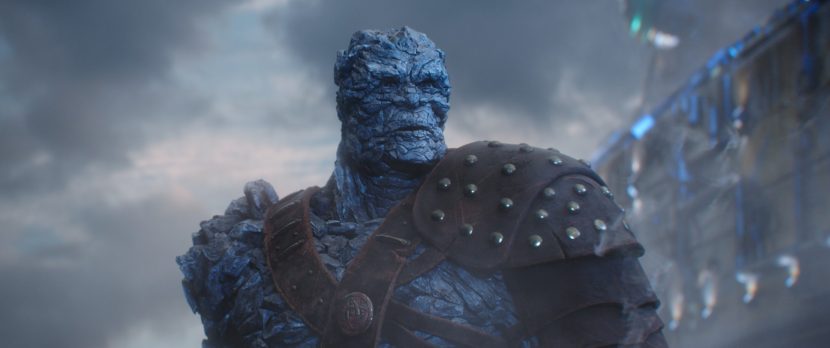
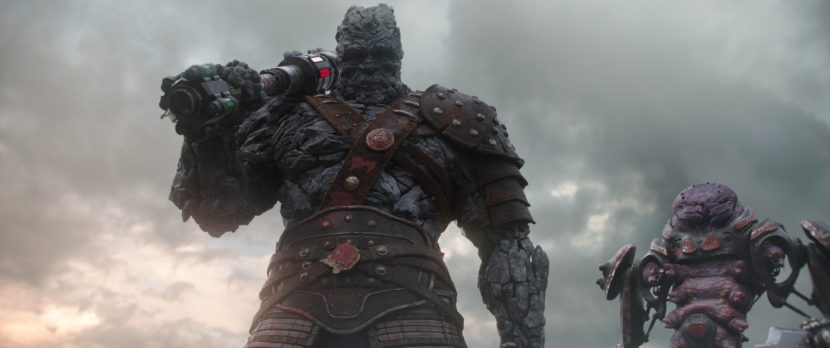
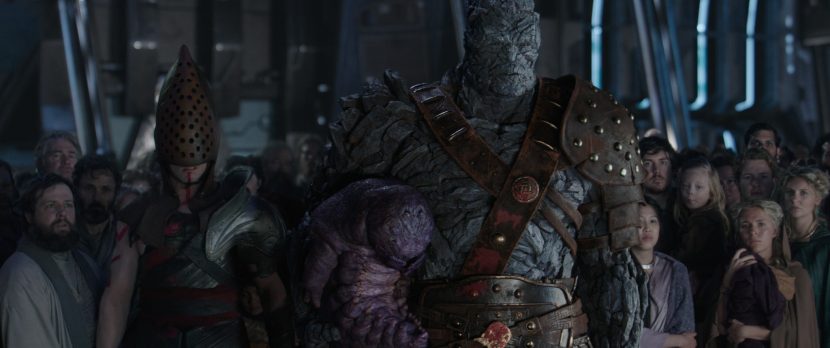
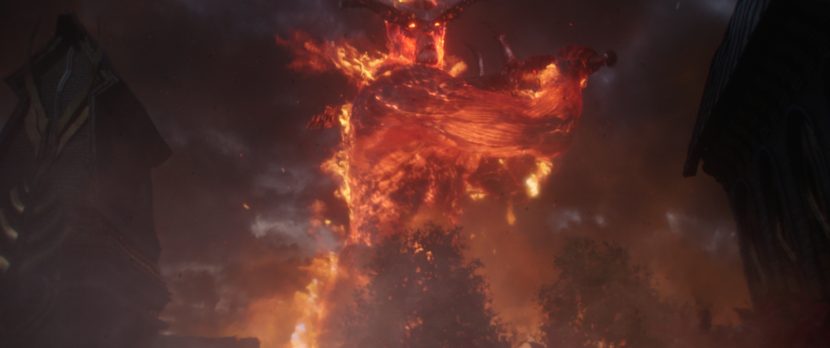
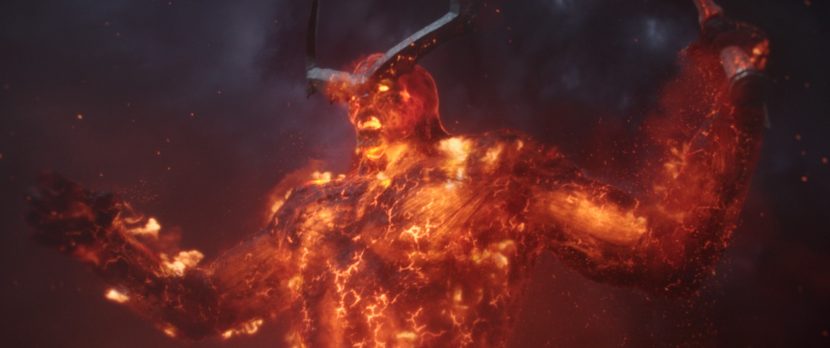
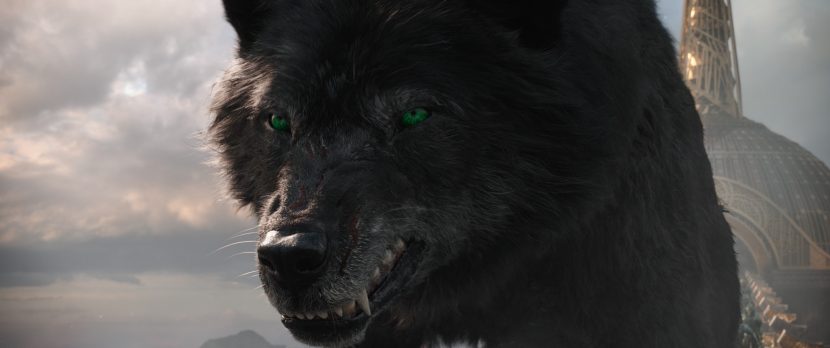
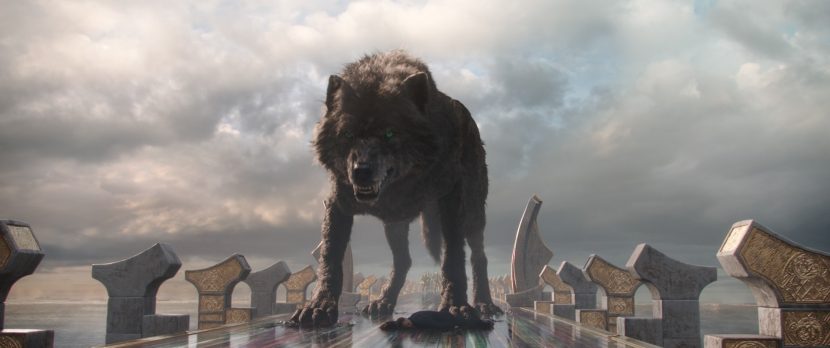
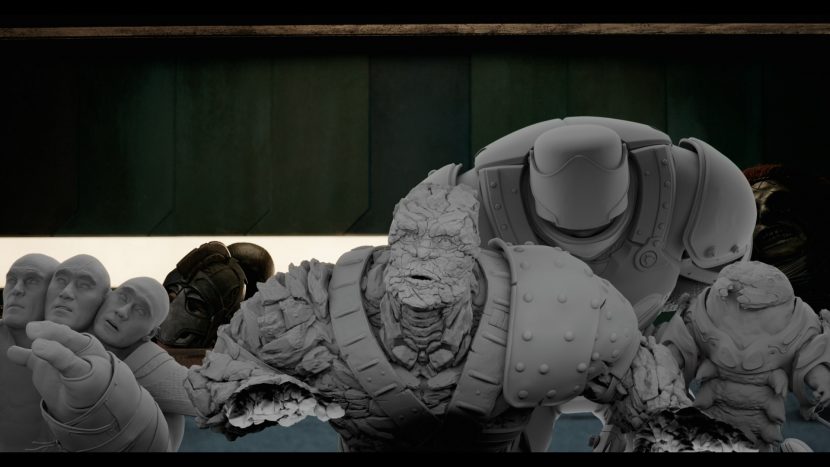
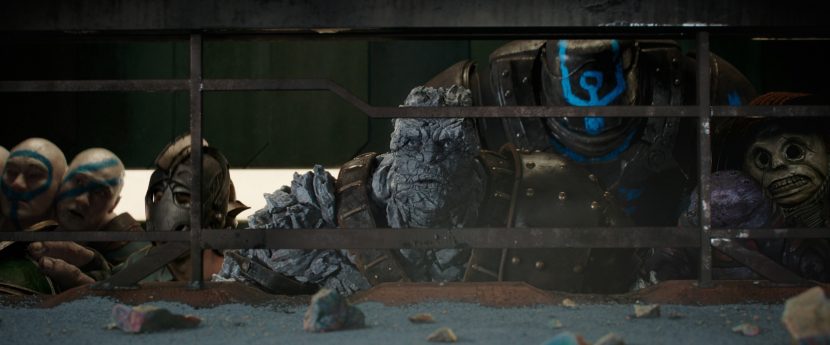
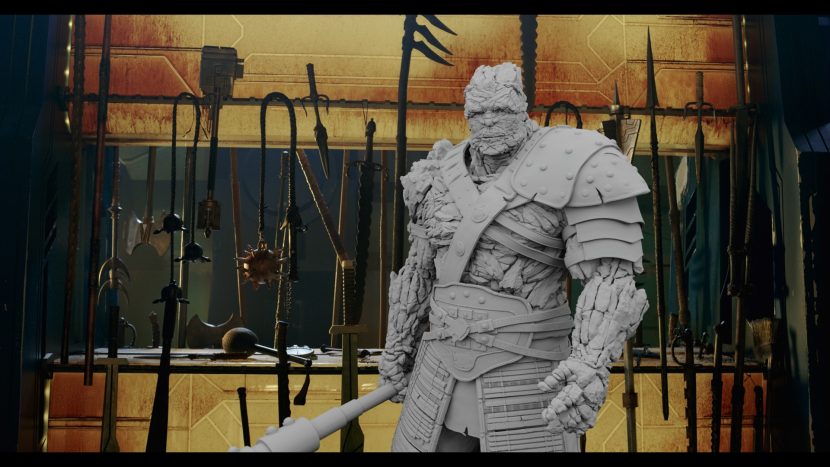
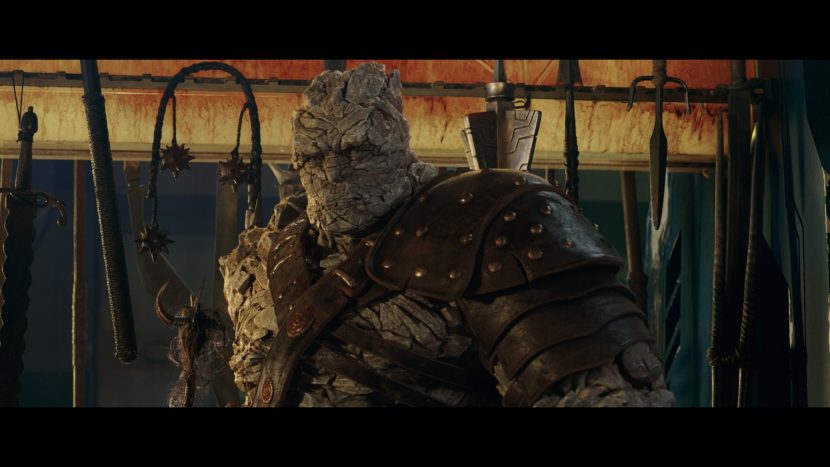
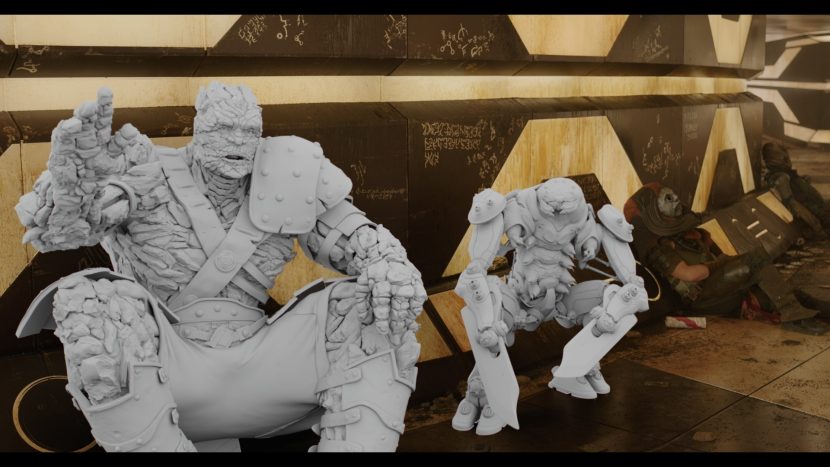
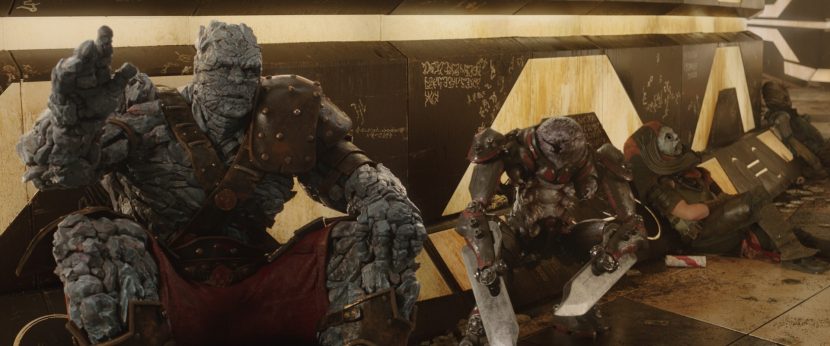
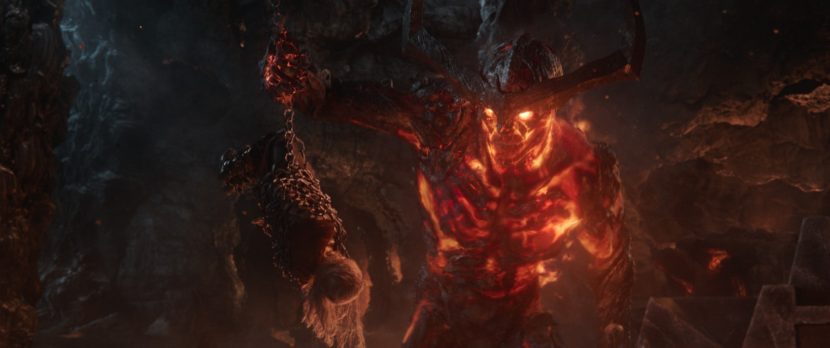
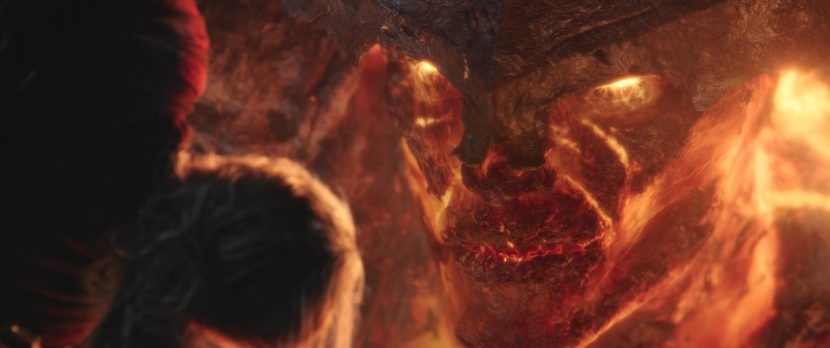
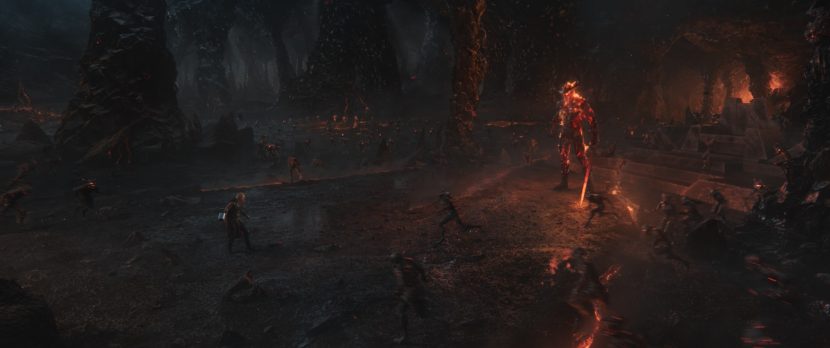
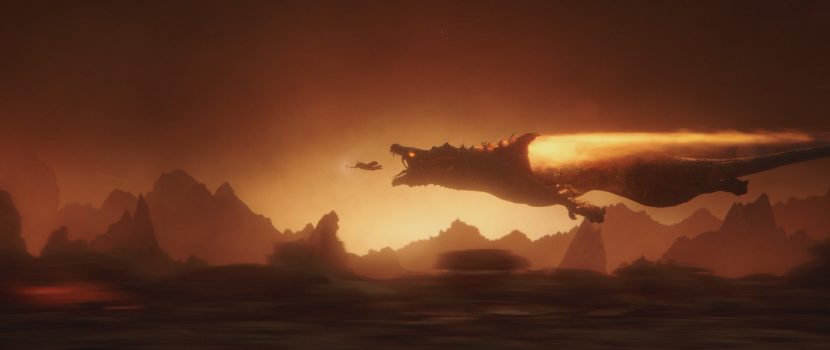
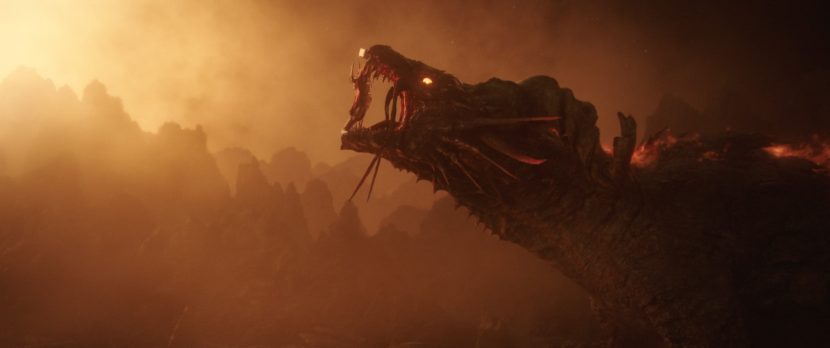
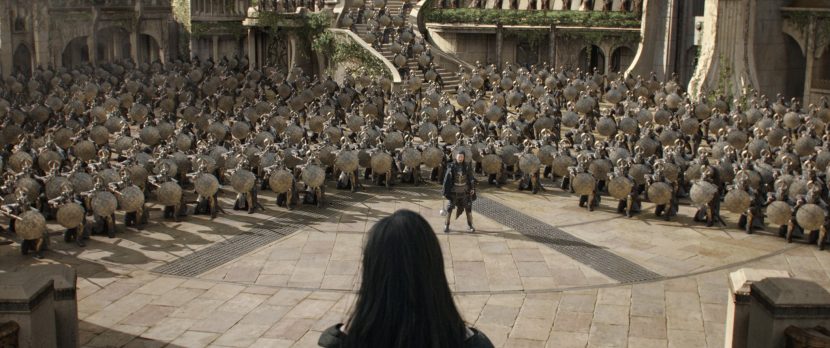
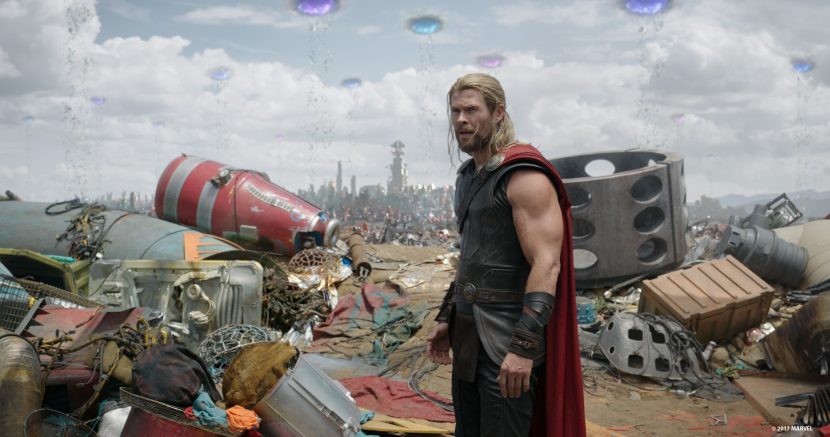
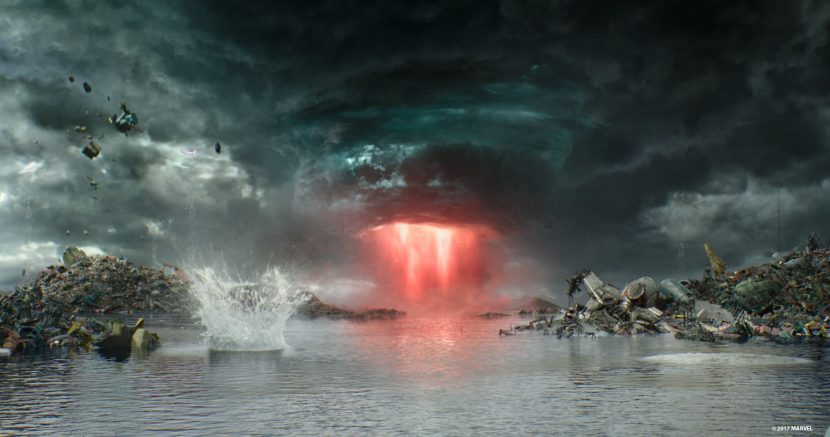
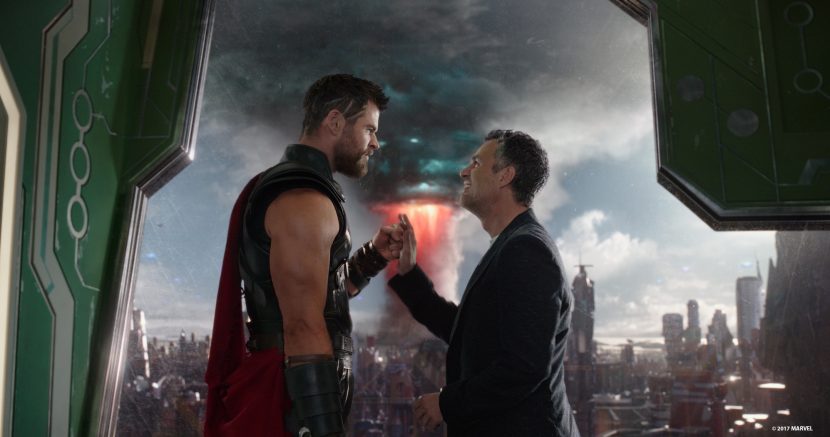
Very impressive article and great work ! My son and I really enjoyed the film, its humour, and lot of it comes from the performance of Hulk. Kudo to the riggers !
By the way, you say « Rigging has no silver bullet, no single tech innovation that has made rigging easier. It is the legendary Greek Sisyphus of visual effects. »
As a great writer said, Albert Camus, in the Myth of Sisyphus : « the struggle toward the top is sufficient in itself to fill a man’s heart. We have to imagine Sisyphus happy ». So, are Riggers the happiest guys in VFX ?? 🙂